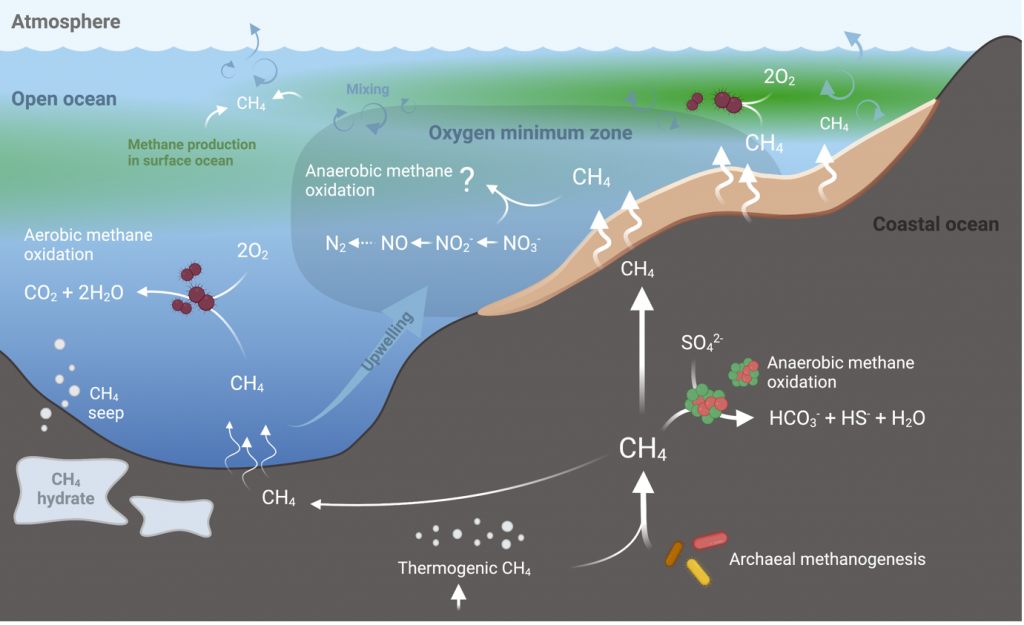Now as the thesis is submitted, here a summary of what it contains:
Contemporary dynamics in atmospheric concentrations of methane – a major regulator of global climate – have challenged our understanding of the global methane cycle, stressing the need for refining global methane sources and sinks. Coastal and shelf waters constitute the largest and most uncertain term in the marine methane emission budget, and while oxygen-depleted coastal waters contain particularly high concentrations of methane, little is known about their effect on emissions. In theory, these anoxic methane-rich waters also constitute ideal niches for anaerobic methane oxidation, yet this process and its potential role in flux mitigation has still not been explored in these systems, which in light of their predicted expansion is the knowledge gap motivating this thesis.
This thesis studies the dynamics, pathways, and controls of anaerobic methane oxidation in two model systems: the seasonally anoxic Mariager Fjord, Denmark, and the coastal oxygen minimum zone (OMZ) of Golfo Dulce, Costa Rica. Manuscript I describes how the seasonal development of anoxia in Mariager Fjord influences the activity and community composition of methanotrophs. Methane accumulated to as much as 1.4 µM in anoxic bottom waters, yet its flux to surface waters was mitigated by efficient methane oxidation near the oxic-anoxic interface. This activity could be conducted both aerobically and anaerobically with near equal efficiency and was most likely mediated by the putatively aerobic Methylococcales of the Deep Sea-1 clade. Manuscript II and III describe pathways and long-term dynamics of anaerobic methane oxidation in the Golfo Dulce OMZ. In Manuscript II, a three-year study found stable, high concentrations of methane (up to 1.7 µM) and efficient anaerobic methane oxidation in the OMZ core, the latter constituting a substantial methane sink. Here, OPU3 and Deep Sea-1 clades of the Methylococcales were the most likely conveyors. Both clades always peaked in relative abundance in the OMZ core, indicating an adaptation to the anoxic environment. With their potential for an anaerobic metabolism unexplored and the methane oxidation pathway still elusive, Manuscript III used metagenomics and targeted rate and inhibitor experiments to address these knowledge gaps. Here, we showed that anaerobic methane oxidation was likely linked to denitrification. In addition, we resolved a niche partitioning of three Methylococcales lineages (ecotypes) in the OMZ, and based on functional analysis, we hypothesize that differences in capacity for denitrification, oxygen respiration, and motility sustain their presence and activity at different depths in the OMZ. Overall, this thesis has shown that oxygen-depleted coastal waters are environments with efficient methane turnover, and based on our estimates, the methane accumulating there does not influence regional atmospheric methane emissions.

And if anybody should happen to be interested in an Icelandic version:
Metan er 28 sinnum virkari gróðurhúsalofttegund en koldíoxíð. Frá um 1990 hafa óútskýrðar sveiflur í þéttni metans í andrúmslofti jarðar ögrað þekkingu okkar á hringrás metans og lagt áherslu á nauðsyn þess að rannsaka framleiðslu og niðurföll metans í umhverfinu. Grunnsævi standa fyrir bæði mestu og mestri óvissu losun á metan gasi úr hafi, og þó svo að einkar há þéttni af metani fyrirfinnist á súrefnisnauðum hafsvæðum, þá er lítið vitað um afleiðingar þess á losun til andrúmsloftsins. Fræðilega séð eru þessi súrefnissnauðu svæði tilvalin fyrir loftfirrta metan oxun, en litlar sem engar rannsóknir á þessu ferli og hugsanlegu hlutverki þess í að draga úr losun hafa farið fram til þessa. Í ljósi þenslu þessara svæða á heimsvísu var þetta þekkingarbil hvatinn að þessari ritgerð.
Í þessari ritgerð er fjallað um rannsókn á virkni, ferlum og stjórn loftfirrtrar metanoxunar í tveimur mismunandi kerfum: árstíðarbundna súrefnissnauða Mariager firði í Danmörku og strandlæga súrefnislágmarkssvæðinu í Golfo Dulce, Kosta Ríka. Handrit I lýsir því hvernig árstíðarbundin þróun súrefnisskorts í Mariager firði hefur áhrif á virkni og tegundir metan oxandi örvera. Þéttni metans jókst upp í allt að 1.4 µM í súrefnissnauðu botnvatni fjarðarins, en flæði þess til yfirborðsins var heft af skilvirkri metan oxun nálægt súrefnisríka-súrefnissnauða snertifletinum. Metan oxun fór fram bæði loftháð og loftfirrt af jafn mikilli skilvirkni og virtist vera miðlað af Methylococcales örverum af Deep Sea-1 ættbálkinum, sem taldar eru vera loftháðar. Handrit II og III lýsa ferlum og langtíma virkni loftfirrtrar metanoxunar á súrefnislágmarkssvæðinu í Golfo Dulce. Þriggja ára rannsókn lýst í Handriti II mældibæði stöðuga háa metanþéttni (til 1.7 µM) og skilvirka loftfirrta metanoxun, það síðaranefnda reyndist vera mikilvægt niðurfall fyrir metan á svæðinu. Hér voru OPU3 og Deep Sea-1 ættbálkarnir af Methylococcales líklegustu miðlarnir. Báðir ættbálkar náðu hlutfallslegri hámarksþéttni í súrefnissnauðu botnvatni og virtust þar með vera aðlagaðir að loftfirrtum aðstæðunum. Þar sem engar rannsóknir hafa skoðað eiginleika þeirra fyrir loftfirrtu umbroti og ferlar metan oxunar enn voru óskýrir, voru erfðarannsóknir og markvissar hraða- og hindra tilraunir nýttar í Handriti III til að takast á við þessi þekkingarbil. Rannsóknin leiddi í ljós að loftfirrt metanoxun var líklega tengd við afnitrun. Einnig greindist mismunandi þéttleikadreifing þriggja Methylococcales ættbálka með dýpt á súrefnislágmarkssvæðinu. Á grundvelli greiningar á genamengi má leiða að því líkum að mismunur á afnitrunar-getu, súrefnisnæmi, og hreyfigetu séu meginþættir sem hafa áhrif á þéttni og virkni þessara ættbálka á misjöfnu dýpi á svæðinu. Heilt yfir litið hefur þessi rannsókn sýnt að súrefnissnauð grunnsævi eru svæði með skilvirka metan oxun, og á grundvelli niðurstaðna, þá hefur metanið sem safnast fyrir í þessum svæðum ekki áhrif á svæðisbundna metanlosun til andrúmsloftsins.
